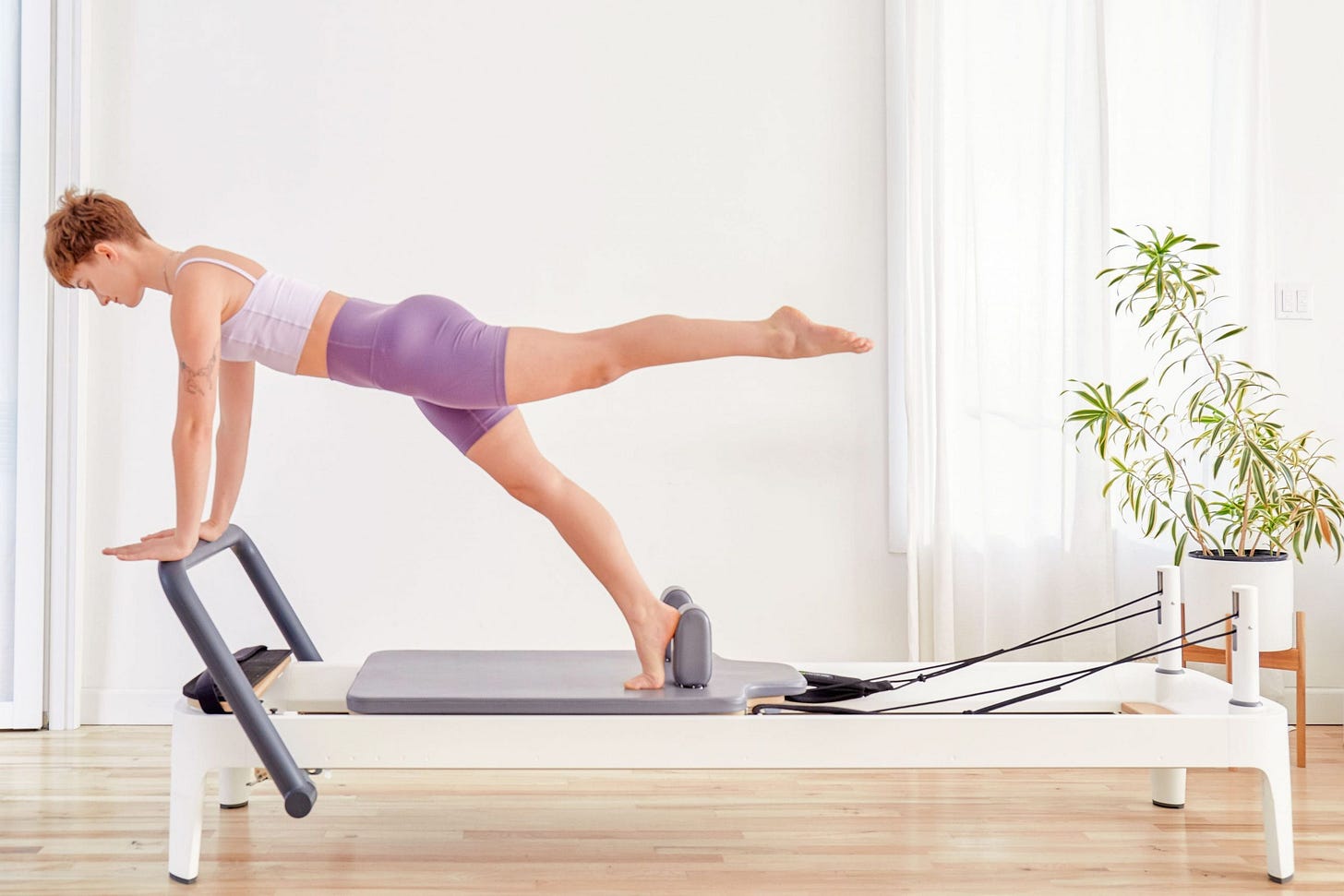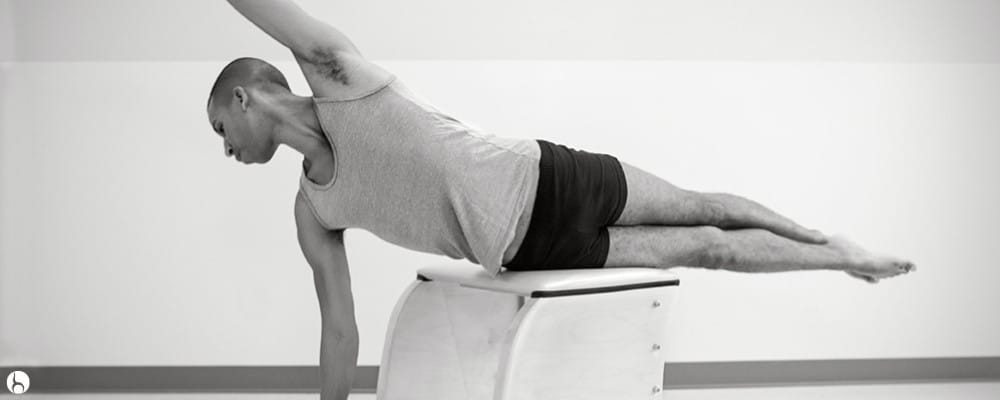Pilates: It ain't the whole meal
Also entitled: nothing is a magical, mystical silver bullet, not even a cool-ass apparatus.
Recently, I met a new client who had seen two pelvic floor providers in the three years before meeting me. “I’m kind of a lost cause,” she said, obviously full of emotion.
She wasn’t. She simply had an undiagnosed prolapse and global weakness that was driving her incontinence symptoms, and needed guidance and treatment accordingly. During her intake, I asked her: What do you like to do for movement?
“Pilates,” she said. “I go twice a week. And, I just started weight training!”
I sighed in relief.
Here’s the tl;dr:
Pilates, like all movement, is great. If you like it, keep at it!
Like all types of exercise, there are pros and cons related to the pelvic floor. Pilates can be great at building small, stabilizing muscles that are frequently overlooked by strength training. It can also create challenges with abdominal tension and intra-abdominal pressure management.
The literature is pretty clear: Pilates does not statistically improve pelvic floor function when compared with controls.
Related reading:
“Will my vagina fall out?” An ode to pelvic organ prolapse. I talk about prolapse a bunch in this article, and in case you need more info, here it is!
Mula bandha, boat pose, and all of my yoga pet peeves. Because I am a former/kind of present day yoga teacher, I go hard on this one.
Okay, fine, let’s talk about abs. On the core and abdominal fascia to pelvic floor connection.
Deadlifts, lunges, squats, oh my! Hands down, I’d recommend strength training over yoga or pilates any day to the strong majority of my clients (if I had to choose only one). Here’s why.
The deep dive:
First things, first, let’s shout out the titans who have written about Pilates and Pilates culture in amazing ways:
The amazing
who inspired the title of this piece, wrote What is the Actual Deal with Pilates, which is a great piece on the ins and outs of Pilates movement (more broadly) and Pilates culture.I would be remiss if I didn’t reference
who wrote the incredible The long con of Pilates culture that goes hard at the whole “long and lean” marketing that Pilates culture capitalizes on.
I’ll be focusing here specifically on how Pilates (the exercise format) interfaces with the pelvic floor, so let’s make magic happen.
I am a movement optimist, and I will die on this hill. Movement is good. If you like a specific kind of movement, good! I love that for you.
And here’s the big caveat: no specific style of movement is coming to save you. IMO, the closest we get is walking and strength training, and even those modalities are not end-all-be-all pelvic floor saviors, because literally nothing is. Bodies are different, brains are different, and bodies shift throughout the lifespan. Everyone is going to need a slightly different ratio of training, body work, and/or specific therapeutic movement, and that will very likely change over time.
But I frequently (frequently!) hear that Pilates is a low-key replacement for your pelvic floor. Amazing for your pelvic floor. I just can’t universally get behind this statement. Instead, let’s break it down.
The good:
The deep core vibes: When we say “deep core”, most folks in the fitness and rehabilitation industry are referring to the transverse abdominis (TA). With that being said, the deep core is actually a set of muscles including the TA in the front, the multifidis in the back (i.e. a pretty small vertical set of muscles running close to and stabilizing the spine), the diaphragm on top, and the pelvic floor on bottom. Here’s the classic image:
When done well and with solid supervision, Pilates has the ability to improve TA strength and deep core control.
I personally love using TA and deep core training to improve pelvic floor muscle responsiveness! Often, the pelvic floor comes along for the ride, and it’s absolutely magical. I think this is where the whole conflation of Pilates = basically as good as pelvic floor therapy comes from, and I get it! We’ll get to the gaps in a bit.
Breath + body awareness: It’s my personal observation that folks who regularly engage with Pilates tend to have excellent body awareness and control. This means that if there are gaps in deep core function, they can frequently connect with those spaces and, because their neuromuscular awareness (fancy way of saying mind-body connection) is already rock solid, they generally make faster progress.
An emphasis on pelvic mobility: As I wrote just last week, pelvic mobility is a freaking rock star of pelvic health. If you can get right with your pelvic mobility, you’re stacking the cards of pelvic floor function in your favor, and I fucking love that for you. Pilates is a big fan of pelvic mobility work, and I’m a huge fan of that!
Eccentric movement, especially with apparatus use: Once again, all movement is great. And! I’m personally a goddamn sucker for eccentric movement for ab work, particularly for people who experience pelvic pain.
Eccentric implies that the muscle is lengthening, not shortening, under load. Since the abdominal wall and anterior pelvic floor share fascia, I feel extra comfy building strength while lengthening that tissue instead of compressing it. (Btw, compression can lead to increased tension and dysfunction — think pain, incontinence, literally whatever the presenting problem is.)
It’s fucking fun! I went to a private Pilates class at my local studio recently to see what it was all about. I hadn’t been on a reformer in years, and it’s definitely not something I’m well versed in. But it was FUN. I got to flip over and use my hard-earned body awareness to do crazy weird and fun party tricks. Party tricks are fun! Joy is important!
The not so great:
Tons of intense ab work: Wait, you may have said, You just fucking told me ab work was good! And you’re right. In some cases, for some people, deep core work as well as a well rounded superficial abdominal work can be great for folks with prolapse and incontinence. But! Remember how I said that lots of ab work can pull on that abdominal fascia and create more tension!?
Yeah. So this happens, and regardless of what’s going on for anyone, it can wreak havoc. I’m talking more pain, urgency, incontinence, increased prolapse symptoms — you name it, it can happen from tension. Tension in your pelvic floor and abdominal wall is basically the devil.
Funky intra-abdominal pressure ishes: What, praytell, is intra-abdominal pressure? Basically it is what it sounds like — the amount of pressure in your abdominal canister. The deal is that if you’re constantly pushing or bearing down — think about pushing out the toughest shit of your life or, you know, a baby — that creates pressure on your pelvic floor. In addition to functional weakness, this is the primary driver of prolapse. My issue is that often, people think they are engaging their TA when in fact, they’re over recruiting the upper obliques and bearing down (trust me, it can be far more subtle than the above examples!). It often takes my clients several cues and about half of a very focused session to get true TA engagement without any additional compensation!
I should say that intra-abdominal pressure shouldn’t be feared — nor should crunches. It’s more about the fact that a lot of people do not manage the pressure well in their systems, and therefore cannot tolerate a shitload of crunch-type movements without negative pelvic floor side effects.
No progressive overload. This is honestly my biggest gripe. A lot of times in the pelvic floor world, we straight up need to build muscle. (This is even true in the case of chronic pain, btw.)
Pilates, while it will definitely increase muscle from those who simply don’t exercise, simply does not offer the progressive overload needed to effectively build muscle over time. Okay, sure, you can do a Mega Reformer or whatever. But most people I treat are hanging out on their mats doing body weight bridges and lunge pulses. These movements are genuinely great (truly, no shade!), but they’re probs not getting you to failure.
Let’s briefly talk about old-school bro science of muscle hypertrophy, aka growth. (No, I will not spout a protein gospel rn.) The science states that there’s a huge range of loads (basically, you can go hella heavy or just low key heavy) but you need a progressive overload to improve muscle growth, strength, and endurance. Additionally, a lot of science favors the idea of going to near failure — failure being the literal inability to do another rep, like you’re stuck in mud.
So if you truly and regularly get to failure during your Pilates class, great! But I came nowhere near close during my one on one Pilates sesh. There were other benefits, but that was not one.
Piety vibes: This has more to do with culture than anything else, but a lot of Pilates instructors and practitioners seem to feel that Pilates is superior as a movement modality for the pelvic floor. This is simply not true. Pelvic floor therapy always wins this comparison in studies, which I think has a lot to do with a more specific plan of care. I’m a little allergic to this vibe at this point in my life.
Here’s the take-home:
While there are a few small studies showing that Pilates is beneficial for incontinence (but — literally in the same study, not as good as pelvic floor muscle training), it does not hold up nearly as well to the benefits of pelvic floor therapy. As
says, it’s not the whole meal when it comes to fitness.A meta analysis showed pretty substantively that Pilates does not improve pelvic floor function in healthy cis-female people. But that doesn’t mean you should stop doing it! If you like Pilates, there are some fantastic benefits. It’s just not the end-all-be-all because, once again, literally nothing is.
I should acknowledge that while I feel like I come out swinging pretty hard in favor of strength training here, I fucking love moving with light weights. In fact, I teach classes that feel a helluva lot like Pilates (I’ve never been certified and would never pretend that I actually teach any Pilates methodology!).
There’s benefit here. It’s just not the whole meal. And if you don’t like Pilates, guess what? It’s totally fine. There are so many ways to move and support your pelvic floor (and overall) health. Fuck around, find out, and do what’s feeling good to you at this point in your life.
As always, I am rooting for you. Comment below or respond to this email to tell me what you thought or ask a question!







